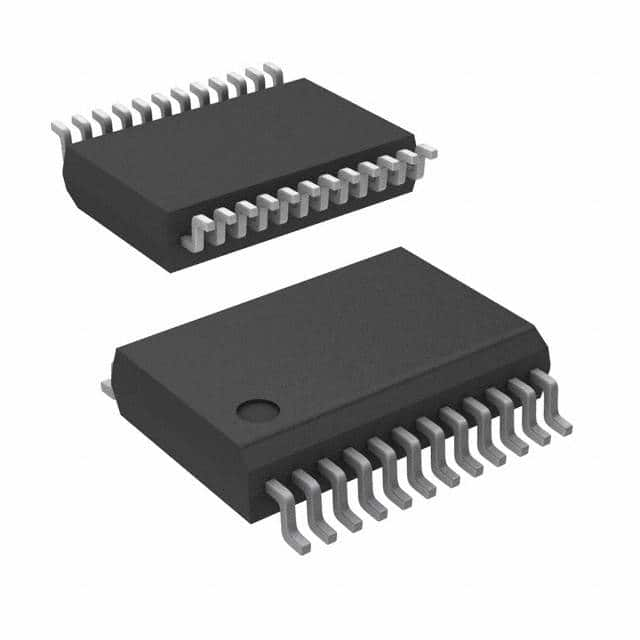PCF8575CDBG4
Overview
- Category: Integrated Circuit (IC)
- Use: I/O Expander
- Characteristics: 16-bit remote I/O expander for I2C-bus with interrupt
- Package: TSSOP-24
- Essence: The PCF8575CDBG4 is a versatile I/O expander IC that allows users to increase the number of input/output pins on a microcontroller or other devices using the I2C-bus protocol.
- Packaging/Quantity: Available in reels of 2500 units
Specifications
- Supply Voltage Range: 2.3V to 5.5V
- Input/Output Voltage Range: 0V to VDD
- Maximum Output Current: 25mA per channel
- I2C-bus Interface: Compatible with I2C Fast-Mode, Standard-Mode, and SMBus protocols
- Interrupt Output: Active-low open-drain output
- Operating Temperature Range: -40°C to +85°C
Pin Configuration
The PCF8575CDBG4 has a total of 24 pins arranged as follows:
___________
| |
1 | 24 | GND
2 | 23 | P7
3 | 22 | P6
4 | 21 | P5
5 | 20 | P4
6 | 19 | P3
7 | 18 | P2
8 | 17 | P1
9 | 16 | P0
10 | 15 | INT
11 | 14 | SDA
12 | 13 | SCL
|___________|
Functional Features
- 16-bit remote bidirectional I/O port
- I2C-bus interface for easy communication with microcontrollers and other devices
- Interrupt output pin for efficient event-driven applications
- Low standby current consumption for power-sensitive applications
- Internal power-on reset to ensure reliable operation during startup
Advantages and Disadvantages
Advantages: - Allows expansion of I/O pins without using additional microcontroller pins - Easy integration with existing I2C-bus systems - Interrupt feature enables efficient event handling - Low power consumption in standby mode
Disadvantages: - Limited to 16 I/O pins, may not be suitable for applications requiring a larger number of I/Os - Requires knowledge of the I2C-bus protocol for proper usage
Working Principles
The PCF8575CDBG4 operates as an I/O expander by communicating with a microcontroller or other devices through the I2C-bus interface. It provides 16 bidirectional I/O pins that can be individually configured as inputs or outputs. The device uses a 7-bit address on the I2C-bus, allowing multiple PCF8575CDBG4 ICs to be connected in parallel.
When connected to a microcontroller, the PCF8575CDBG4 can be used to expand the number of available I/O pins, enabling the control of various peripheral devices such as sensors, switches, LEDs, and more.
Detailed Application Field Plans
The PCF8575CDBG4 finds applications in various fields, including but not limited to:
- Industrial automation: Used to interface with sensors, actuators, and control devices in manufacturing processes.
- Home automation: Enables the control of lights, appliances, and security systems.
- Internet of Things (IoT): Facilitates the connection of multiple devices in IoT applications.
- Robotics: Provides additional I/O pins for controlling motors, sensors, and other components.
- Automotive electronics: Used for interfacing with various automotive systems, such as lighting controls and dashboard displays.
Detailed and Complete Alternative Models
- PCF8574: 8-bit remote I/O expander with similar features but fewer I/O pins.
- MCP23017: 16-bit I/O expander with similar functionality and I2C-bus interface.
- MAX7313: 16-bit I/O expander with interrupt capabilities and I2C-bus compatibility.
These alternative models offer similar functionality to the PCF8575CDBG4 and can be considered based on specific project requirements.
In conclusion, the PCF8575CDBG4 is a versatile I/O expander IC that provides an easy way to increase the number of I/O pins in microcontroller-based systems. Its I2C-bus interface, interrupt feature, and low power consumption make it suitable for a wide range of applications in various fields.
Lista 10 Vanliga frågor och svar relaterade till tillämpningen av PCF8575CDBG4 i tekniska lösningar
Sure! Here are 10 common questions and answers related to the application of PCF8575CDBG4 in technical solutions:
Q: What is PCF8575CDBG4? A: PCF8575CDBG4 is an I/O expander integrated circuit (IC) that provides additional input/output ports for microcontrollers or other digital devices.
Q: How many I/O ports does PCF8575CDBG4 provide? A: PCF8575CDBG4 provides a total of 16 I/O ports, which can be configured as either inputs or outputs.
Q: What is the voltage range supported by PCF8575CDBG4? A: PCF8575CDBG4 supports a voltage range of 2.3V to 5.5V, making it compatible with a wide range of microcontrollers and digital devices.
Q: Can PCF8575CDBG4 be used with both 3.3V and 5V microcontrollers? A: Yes, PCF8575CDBG4 is designed to work with both 3.3V and 5V microcontrollers, thanks to its wide voltage range support.
Q: How can I communicate with PCF8575CDBG4? A: PCF8575CDBG4 uses the I2C communication protocol, allowing you to easily interface it with microcontrollers or other devices supporting I2C.
Q: Can PCF8575CDBG4 be used for both input and output operations simultaneously? A: Yes, PCF8575CDBG4 can be configured to operate as both input and output ports simultaneously, providing flexibility in your design.
Q: What is the maximum current that can be sourced/sunk by each I/O port? A: Each I/O port of PCF8575CDBG4 can source/sink up to 25mA of current, making it suitable for driving LEDs, relays, and other low-power devices.
Q: Can PCF8575CDBG4 be cascaded to expand the number of I/O ports? A: Yes, multiple PCF8575CDBG4 ICs can be cascaded together using the I2C bus, allowing you to expand the number of available I/O ports.
Q: Is PCF8575CDBG4 compatible with Arduino boards? A: Yes, PCF8575CDBG4 is compatible with Arduino boards as they support the I2C communication protocol.
Q: Are there any libraries or example codes available for PCF8575CDBG4? A: Yes, there are several libraries and example codes available for PCF8575CDBG4 that can be easily found online, making it easier to integrate into your projects.
Please note that these answers are general and may vary depending on specific implementation details and requirements.


